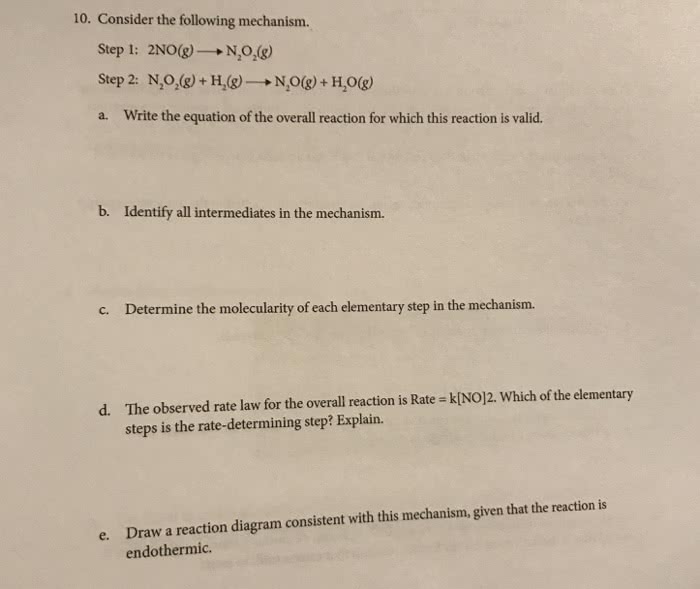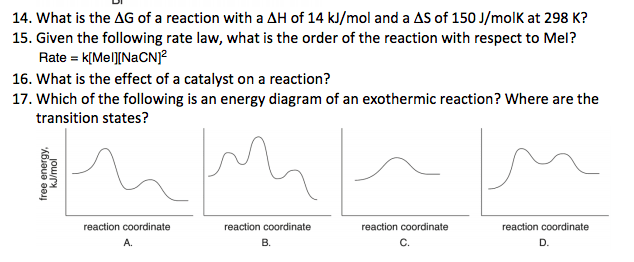CHEM 101DL Study Guide - Midterm Guide: Equilibrium Constant, Rate Equation, Reaction Intermediate

Chemistry 101DL
Summer I, 2018
Dr. T. Woerner
Kinetics Problems
1. Define the following: (a) transition state, (b) energy of activation, (c) reaction order,
(d) catalyst, (e) rate-determining step, (f) reaction intermediate.
2. Draw a potential energy diagram for the hypothetical reaction
A(g) + B(g) 2C(g)
for which Ea(forward) is 154.81 kJ and Ea(reverse) is 104.6 kJ. Indicate the magnitude of
on the diagram. Is the reaction exothermic or endothermic? Draw a curve for a
catalyzed reaction on the diagram.
3. The rate equation for the reaction
2NO(g) + 2H2(g) N2(g) + 2H2O(g)
is second order in NO(g) and first order in H2(g). (a) Write a rate equation for this
reaction. (b) If concentrations are expressed in mol/liter, what units would the rate
constant, k, have? (c) If concentrations are expressed in atmospheres, what units would
k have?
4. For the reaction in which A and B react to form C, the following data were obtained
from three experiments
Experiment
[A]
[B]
Rate (formation of C)
1
0.30 M
0.15 M
7.0X10–3
2
0.60 M
0.30 M
2.8X10–2
3
0.30 M
0.30 M
1.4X10–2
(a) What is the rate equation for the reaction? (b) What is the numerical value of the
specific rate constant?
5. For a reaction in which A and B react to form C, the following data were obtained
from three experiments.
Experiment
[A]
[B]
Rate (formation of C)
1
0.03
0.03
0.3X10–3
2
0.06
0.06
1.2X10–3
3
0.06
0.09
2.7X10–3
ΔHo
find more resources at oneclass.com
find more resources at oneclass.com
Document Summary
Kinetics problems: define the following: (a) transition state, (b) energy of activation, (c) reaction order, (d) catalyst, (e) rate-determining step, (f) reaction intermediate, draw a potential energy diagram for the hypothetical reaction. Draw a curve for a for which ea(forward) is 154. 81 kj and ea(reverse) is 104. 6 kj. H catalyzed reaction on the diagram: the rate equation for the reaction. 2. 7x10 3: what is the rate equation for the reaction? (b) what is the numerical value of the specific rate constant, the following data pertain to the decomposition of phosphine gas at 950 k. 0. 00440 atm/sec: what is the order of the rate equation for the reaction? (b) what is the value of the specific rate constant, the reaction. Ch3cl(g) + hcl(g) proceeds by a chain mechanism. The chain propagators are cl atoms and ch3 radicals, and it is believed that free h atoms are not involved.



